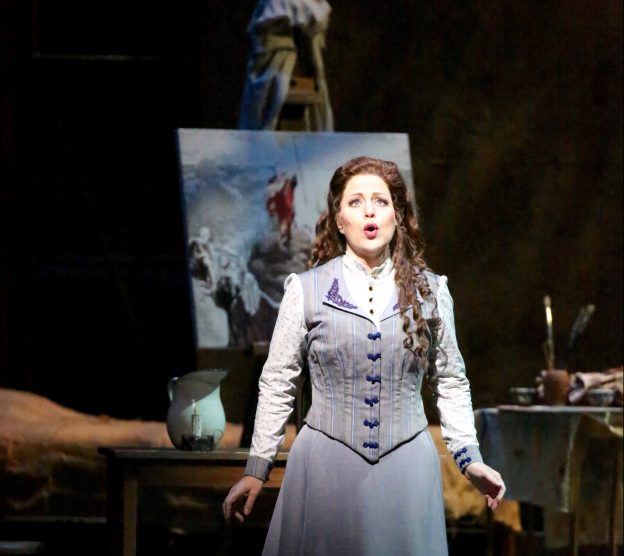
Review – Women dominate strong cast in HOT’s superb ‘La Boheme’
Hawai‘i Opera Theatre opened its 2016-17 season with a charming production of Puccini’s “La Boheme” (“The Bohemians”), a tragic love story of universal appeal that is at once personal and epic.
In “La Boheme,” four starving young men — a poet (Rodolfo), painter (Marcello), philosopher (Colline) and musician (Schaunard) — are struggling to make their way as artists in the Latin quarter of Paris when Rodolfo falls in love with the gentle Mimi, who is dying of tuberculosis. Marcello and his sometime girlfriend, Musetta, provide high-spirited contrast, and the six form a tight-knit band of working-class comrades, anti-establishment bohemians embracing the fleeting passions of life amid a cruel world.
HOT’s production, designed by Erhard Rom (scenery), Peter Dean Beck (lighting), Kathleen Trott (costumes) and Sue Sittko Schaefer (wigs and makeup), took a traditional approach, matching the opera’s 1896 period with an apt and artful look that supported without intruding.
Scenes are framed by large, proscenium-high cityscapes on side panels in urban grays and browns, with the bohemians and Yuletide celebrations providing color. The stage is dominated by a large central “V” step that interrupts symmetrical rectangularity, much as bohemians disrupted social structure.
The basic set transforms for each act: a slanted garret window for the bohemians’ cozy but cold attic; a festivity of lanterns for the street cafe and bohemians’ high spirits; a snowy city gate and lonely lamppost for the lovers’ spats and nadir; and a final return home to the attic.
HOT’s design sidestepped grinding poverty in favor of a more romanticized, genteel poverty that was disrupted only by Colline peeing into the stairwell, which didn’t seem to fit with the tone of the rest.
HOT’s casting was especially strong, and although outnumbered, the women ruled.
Elizabeth Caballero is a wonderful Mimi: Her warm lyric soprano has a gentle tone and an impressively large expressive range, with both power and delicacy. She is also an excellent actress, and her Act III aria — “Addio senza rancor” (“Farewell, with no hard feelings”) — was moving.
Caballero outpowered her partner, Rodolfo, sung by Mackenzie Whitney, whose beautifully clear tenor was stretched by the role but created an appealing leading man. Their Act I “Che gelida manina” (“Such cold hands!”) was charming.
As Musetta, Rachelle Durkin has an equally strong soprano, but with a ringing, brighter tone and more of an edge, which lent spice to her character. She worked well with Wes Mason (Marcello) as the spirited, quarreling couple that kept things lively. Durkin’s “Musetta’s Waltz” was a high point, and her off-stage “come-hither” snippet from the tavern in Act III was especially entrancing.
Mason’s virile baritone paired equally well with Caballero’s soprano, which made them especially simpatico friends.
Nathan Stark (Colline) is a bear vocally and physically, which made his farewell ode to his coat especially comical; Michael Weyandt (Schaunard) shone in his Act I caper about poisoning the parrot; and Kevin J. Glavin blundered and blustered memorably as both Benoit and Alcindoro.
Local singers in the hubbub of Act II included Johnathan Sholtis as Parpignol, the toy vendor; brothers Michal and Karol Nowicki, originally from Poland; Ian McMillan; and the Hawaii Youth Opera Chorus.
Conductor Karen Keltner delivered an outstanding, carefully nuanced interpretation of “La Boheme.” Under her direction, the orchestra sounded excellent, and Keltner crafted a lovely dialogue between pit and stage, pacing the drama while giving singers room to soar.
———
